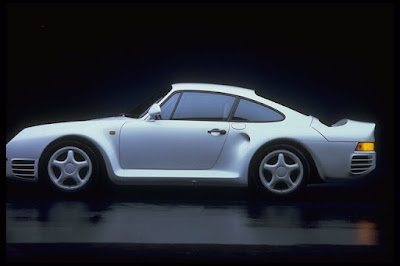 Porsche
Porsche executives soon recognised the need for a higher-performance version of the 924 that could bridge the gap between the basic 924 and the 911s. Having already found the benefits of turbochargers on several race cars and the 1975 911 Turbo,
Porsche chose to use this technology for the 924, eventually introducing the 924 Turbo as a 1978 model.
Porsche started with the same Audi-sourced 2.0 L I4, designed an all new cylinder head (which was hand assembled at Stuttgart), dropped the compression to 7.5:1 and engineered a K-26 turbocharger for it. With 10 psi (70 kPa) boost, output increased to 170 hp (127 kW). The 924 Turbo engine assembly weighed about 65lbs more, so front spring rates and anti-roll bars were revised. Weight distribution was now 49/51 compared to the original 924 figure of 48/52 front to rear.
In order to help make the car more functional, as well as to distinguish it from the naturally-aspirated version,
Porsche added a NACA duct in the hood and air intakes in the badge panel in the nose, 15-inch spoke-style alloy wheels, four-wheel disc brakes with 5 stud hubs and a five-speed transmission. Forged 16" flat wheels from the 928 were optional.
Internally,
Porsche called it 931 (left hand drive) and 932 (right hand drive), much like the 911 Carrera Turbo, which had been "Type 930". These designations are commonly used by 924 aficionados.
The turbocharged engine allowed the 924's performance to come surprisingly close to that of the 911 SC (180 bhp), thanks in part to a lighter curb weight, but it also brought reliability problems.
Intense heat in the engine bay lead to short turbocharger life and turbo-related seal and seat problems. To fix the problems,
Porsche released a revised 924 Turbo series 2 (although badging still read 924 Turbo) in 1981. By using a smaller turbocharger running at increased boost, slightly higher compression of 8:1 and an improved fuel injection system with DITC ignition triggered by the flywheel, reliability improved and power rose to 177 hp (132 kW).
After a successful sales run of both naturally-aspirated and turbo models, in 1981
Porsche decided to surprise everyone and a new 924 variant was unveiled at Le Mans 24 Hours.
By adding an intercooler, increasing compression to 8.5:1 as well as various other little changes,
Porsche was able to develop the 924 Turbo into the race car they had wanted, dubbing it the 924 Carrera GT.
Visually it differed to the 931 in that it had polyurethane plastic front and rear flared guards, a polyurethane plastic front spoiler, a top mounted air scoop for the intercooler, a much larger rubber rear spoiler and a flush mounted front windscreen. It lost the 931's NACA duct in the hood but retained the air intakes in the badge panel. This more aggressive styling was later used for as motivation for the 944.
In order to comply with the homologation regulations, the 924 Carrera GT and later 924 Carrera GTS were offered as road cars as well, producing 210 and 245 hp (157 and 183 kW) respectively. Clubsport versions of the GTS were available with a factory included Matter rollcage and race seats. 924 Carrera GT variations were known by model numbers 937 (left hand drive) and 938 (right hand drive).
The ultimate development of the 924 in its race trim was the 924 Carrera GTR race car, which produced 375 hp (280 kW) from a highly modified version of the 2.0 L I4 used in all 924s except for the 944 Carrera GTP which used a highly modified as yet unreleased 944 2.5 litre DOHC 16v
Porsche unit. This last model variant came 7th overall at Le Mans 24 Hours and spent the least time out of any other car in the pits.
Production of the 924 Turbo ceased in 1982 except for the Italian market which lasted until 1984. This is due to the restrictions on engines larger than 2 liters, putting the 2.5 liter 944 into a much higher tax category.
technorati tags:porsche ,ferrari ,jaguar ,lamborghini ,lotus ,bugatti ,aston martin,maserati ,alfa romeo,cars,sports cars, exotic cars






































